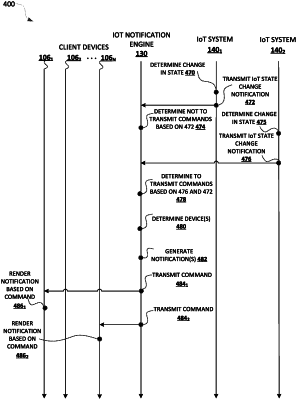| CPC G10L 15/22 (2013.01) [G06F 3/167 (2013.01); G10L 15/08 (2013.01); G10L 15/30 (2013.01); G16Y 40/10 (2020.01); G16Y 40/35 (2020.01); H04L 12/282 (2013.01); H04W 4/70 (2018.02); G10L 2015/088 (2013.01); G10L 2015/223 (2013.01)] | 20 Claims |

|
1. A method comprising:
receiving, via one or more network interfaces of an automated assistant computing system:
a first IoT state notification from a first third-party system, the first IoT state notification: transmitted to the automated assistant computing system, indicating a first state associated with a first group of one or more IoT devices, and comprising: a unique identifier and a first state indication that indicates the first state associated with the first group of one or more IoT devices;
a second IoT state notification from a second third-party system, the second IoT state notification transmitted to the automated assistant computing system and indicating a second state associated with a second group of one or more IoT devices and comprising: the unique identifier or an additional unique identifier, and a second state indication that indicates the second state associated with the second group of one or more IoT devices;
determining to transmit a combined notification that is based on both the first IoT state notification and the second IoT state notification, wherein determining to transmit the combined notification is based on determining, based on the first IoT state notification and the second IoT state notification, that the first state and the second state are co-occurring;
identifying, by the automated assistant computing system based at least in part on the unique identifier, a plurality of candidate assistant client devices that each have a corresponding automated assistant client and that are each associated with both the first group of one or more IoT devices and the second group of one or more IoT devices;
selecting at least one of the candidate assistant client devices; and
transmitting, to the at least one of the candidate assistant client devices, a command that includes the combined notification and that causes the automated assistant client of the at least one of the candidate assistant client devices to:
automatically render the combined notification via at least one user interface output device of the at least one of the candidate assistant client devices.
|